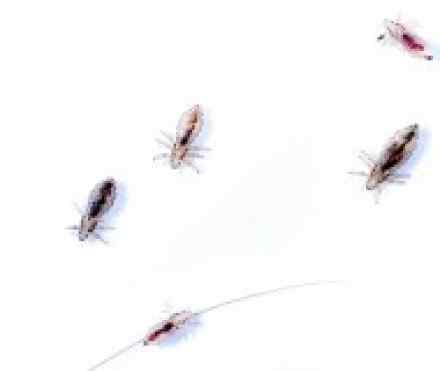
What is it?
- Body lice are tiny, wingless, parasitic insects that may be found on your body and in the seams and folds of your clothing. Body lice are a different type from head lice and pubic lice, though they're all similar.
- Body lice feed on your blood and can cause symptoms such as itching. Body lice are most common where people live in crowded and unhygienic conditions. The lice are easily spread by close contact and by sharing bedding or clothing.
- If you have body lice, you generally don't need treatment. However, you must take measures such as properly treating your clothing and other items to avoid reinfesting yourself or spreading body lice to others.
Symptoms
Body lice infestationBody lice can be found anywhere on your body, and particularly in the seams of your clothing. If you have body lice, you may experience:
- Itching. Intense itching on your body.
- Rash. You may have an allergic reaction to the lice bites, resulting in a rash.
- Lice or eggs (nits) on your body or in your clothing. Body lice feed on your blood but then return to your clothing to live and lay eggs. You may see lice on your body, but body lice primarily live in clothing, particularly the seams.
- Skin changes. If you're infested with body lice for a long time, you may experience skin changes such as thickening and discoloration in the areas most heavily infested.
Causes
Body lice are scientifically known as Pediculus humanus corporis. Body lice are a different type of lice from those involved in head lice and pubic lice infestations, though they're all similar. Body lice are the largest of the three types.
Body lice feed on your blood but primarily live and lay eggs (nits) in your clothing. Body lice infestations are caused by exposure to body lice or their eggs through:
- Direct contact with someone infested with body lice. This is why body lice are particularly common in people who live in crowded conditions.
- Contact with infested clothing or other items. Infested items may include clothing, bedding and towels. Body lice can survive on these personal items for as long as 30 days.
Risk factors
You are at higher risk of body lice if you:
- Live in crowded conditions
- Live in unhygienic conditions
- Have close contact with anyone who has body lice
- Share clothing, bedding or towels with someone who has body lice
Complications
Body lice infestations usually cause minimal problems. However, a body lice infestation sometimes leads to complications such as:
- Secondary infections. When body lice scratch and dig to feed on your blood, they may irritate your skin. If you scratch to alleviate itching, this also can irritate your skin. If your skin becomes raw from these irritations, other infections may develop.
- Skin changes. If you're infested with body lice for a long time, you may experience skin changes such as thickening and discoloration.
- Spread of disease. Although rare, body lice can carry and spread some bacterial diseases, such as typhus, relapsing fever or trench fever. All of these diseases can be treated with antibiotics. But if left untreated, they can result in death
Diagnosis
You or your doctor can usually confirm a body lice infestation through a visual examination of your body and clothing items. The presence of eggs and moving lice confirms infestation.
Treatments and drugs
- Body lice are primarily treated by thoroughly washing yourself and any contaminated items with soap and hot water.
- If these measures don't work, you can try using an over-the-counter lotion or shampoo — such as Nix or Rid. If that still doesn't work, your doctor can provide a prescription lotion. Lice-killing products can be toxic to humans, so follow the directions carefully.
Lifestyle remedies
- You can usually get rid of body lice by cleaning yourself and any personal belongings that may be contaminated. Wash infested bedding, clothing and towels with hot, soapy water — at least 130 F (54 C) — and dry them at high heat for at least 20 minutes.
- Items that can't be washed may be sealed in a plastic bag for two weeks.
Prevention
To prevent body lice infestation, avoid having close physical contact or sharing bedding or clothing with anyone who has an infestation.
References:
http://www.cdc.gov/parasites/lice/body/gen_info/faqs.html
http://www.healthline.com/health/body-lice
https://www.nlm.nih.gov/medlineplus/ency/article/000838.htm
http://www.drugs.com/health-guide/body-lice.html
http://www.medicinenet.com/image-collection/body_lice_picture/picture.htm

